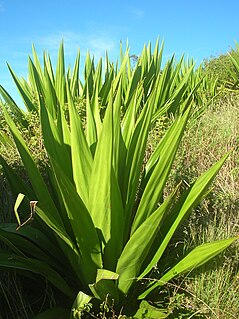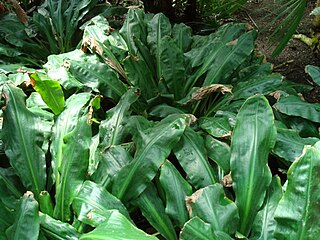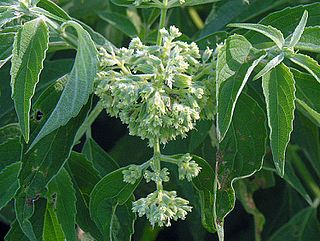
Furcraea foetida is a species of flowering plant native to the Caribbean and northern South America. It is widely cultivated and reportedly naturalized in many places
Mareya is a plant genus of the family Euphorbiaceae, first described as a genus in 1860. It is native to tropical western and central Africa.
Mareyopsis is a plant genus of the family Euphorbiaceae first described as a genus in 1919. It is native to western and central Africa.
- Mareyopsis longifolia(Pax) Pax & K.Hoffm. - Nigeria, Cameroon, Gabon, Equatorial Guinea, Congo-Brazzaville, Zaire
- Mareyopsis oligogynaBreteler - Gabon
Discoglypremna is a plant genus of the family Euphorbiaceae first described as a genus in 1911. It contains only one known species, Discoglypremna caloneura, native to tropical Africa.

Panda is a plant genus of the family Pandaceae. It contains only one known species, Panda oleosa, native to western and central Africa.
Klaineanthus is a genus of plants, under the family Euphorbiaceae. There is only one known species, Klaineanthus gaboniae, native to central Africa.
Manniophyton is a genus of lianas of the spurge family (Euphorbiaceae) described as a genus in 1864. It contains only one known species, Manniophyton fulvum, native to tropical western and central Africa from Guinea to Angola.

Basilicum is a genus of plants in the Lamiaceae, first described in 1802. It contains only one known species, Basilicum polystachyon, native to Africa, Madagascar, southern Asia, New Guinea, Australia, and various islands of the Pacific and Indian Oceans.
Pleioceras is a genus of plants in the family Apocynaceae, first described as a genus in 1888. It is native to tropical Africa.

Palisota barteri is a species of plant in the Commelinaceae family, described in 1862. It is native to western + central Africa.

Lasimorpha is a monotypic genus of flowering plants in the family Araceae. The single species that makes up the genus is Lasimorpha senegalensis. This species is native to western and central Africa, from Liberia east to Chad and south to Angola.
Vossia is a genus of Asian and African plants in the grass family.

Picralima is a plant genus in the family Apocynaceae, first described as a genus in 1896. It contains only one known species, Picralima nitida, native to tropical Africa.
Motandra is a genus of plant in the family Apocynaceae native to tropical Africa. As of August 2013 the World Checklist of Selected Plant Families recognises 3 species:
- Motandra guineensis(Thonn.) A.DC. - widespread from Liberia to Sudan and south to Angola
- Motandra lujaeDe Wild. & T.Durand - Gabon, Congo, Cabinda, Equatorial Guinea, Zaire
- Motandra poecilophyllaWernham - Gabon, Congo, Equatorial Guinea, Cameroon
- Motandra erlangeriK.Schum = Oncinotis tenuilobaStapf
- Motandra glabrataBaill. = Oncinotis glabrata(Baill.) Stapf ex Hiern
- Motandra viridifloraK.Schum. = Baissea viridiflora(K.Schum.) de Kruif
- Motandra welwitschianaBaill. = Oncinotis hirtaOliv.

Hoslundia is a genus of flowering plant in the family Lamiaceae, first described in 1804. It contains only one known species, Hoslundia opposita. It is widespread across much of sub-Saharan Africa including Madagascar.
Cyclocotyla is a genus of plants first described in 1908. It contains only one known species, Cyclocotyla congolensis, native to central Africa.
Dictyophleba is a genus of flowering plants in the family Apocynaceae first described as a genus in 1898. It is native to Africa and to the Comoros Islands in the Indian Ocean.
- Dictyophleba leonensis(Stapf) Pichon - West Africa from Cameroon to Liberia
- Dictyophleba lucida(K.Schum.) Pierre - Comoros, central + southern Africa from Nigeria east to Tanzania and south to Zimbabwe
- Dictyophleba ochracea(K.Schum. ex Hallier f.) Pichon - central Africa from Nigeria to Zaire
- Dictyophleba rudensHepper - Cameroon
- Dictyophleba setosaB.de Hoogh - Cameroon, Gabon
- Dictyophleba stipulosa(S.Moore ex Wernham) Pichon - from Ivory Coast to Congo-Brazzaville
Orthopichonia is a genus of plants in the family Apocynaceae, first described as a genus in 1953. It was initially given the name Orthandra, but this turned out to be an illegitimate homonym. Orthopichonia is native to Africa.
Saba is a genus of plant in the family Apocynaceae first described as a genus in 1849. It is native to Madagascar, Comoros, and mainland Africa.
Vahadenia is a genus of flowering plants in the family Apocynaceae, first described as a genus in 1902. It is native to tropical Africa.







